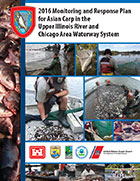
Download the 2016 Monitoring and Response Plan (5.9 MB PDF)
Download the Contingency Response Plan - Appendix J (1.8 MB PDF)
Asian Carp Regional Coordinating Committee Releases 2016 Asian Carp Monitoring and Response Plan, Including Contingency Plan
May 24, 2016
Media Contacts:
Illinois Department of Natural Resources, Chris Young, 217-557-1240
U.S. Fish and Wildlife Service, Katie Steiger-Meister, 612-713-5317
Great Lakes Fishery Commission, Marc Gaden, 734-417-8012
U.S. Environmental Protection Agency, Peter Cassell, 312-886-6234
U.S. Army Corps of Engineers, Lynne Whelan, 312-846-5330
The Asian Carp Regional Coordinating Committee (ACRCC) today released its first Contingency Plan which outlines member agencies’ preparedness to defend the Great Lakes from Asian carp in the Illinois River system. The Contingency Plan identifies actions partners will take if Asian carp are detected in new areas or if greater numbers of fish are observed. The plan complements the ACRCC’s 2016 Monitoring and Response Plan which details the scientific basis for control and management efforts to prevent the spread and establishment of Asian carp from the upper Illinois River into the Great Lakes.
“Preventing the spread of Asian carp into the Great Lakes is a shared goal and responsibility,” said Jo-Ellen Darcy, Assistant Secretary of the Army for Civil Works. “This Monitoring and Response Plan is an excellent example of ongoing multi-agency collaboration, which describes a broad range of options for tracking Asian carp locations and contingencies for limiting Asian carp movement toward the Great Lakes.”
“These plans put everyone on the same page as we work together to keep Asian carp out of the Great Lakes,” said Kevin Irons of the Illinois Department of Natural Resources, co-chair of the Monitoring and Response Group of the ACRCC. “The actions spelled out in this plan are clear and aggressive. Our partners conducting the monitoring and control efforts on the upper Illinois River are confident in their ability to support electric barrier operations and keep Asian carp out of Lake Michigan.”
The Monitoring and Response Plan is updated each year, and compiles 22 separate project plans to be undertaken in 2016. The Contingency Plan goes further by outlining aggressive actions partners would take if significant changes are detected in the number or location of Asian carp in the Starved Rock, Marseilles, Dresden Island, Brandon Road and Lockport Pools of the upper Illinois River.
“These plans provide clear direction to our partner agencies who are working to monitor and control Asian carp,” said John Dettmers of the Great Lakes Fishery Commission, co-chair of the Monitoring and Response Group of the ACRCC. “When our biologists detect significant changes in Asian carp numbers, or find fish in new areas, the plan directs us to take immediate action to address the threat of further expansion.”
“The public needs to know that we are prepared for what might happen next,” said U.S. Fish and Wildlife Service Midwest Deputy Regional Director, Charlie Wooley. “If we observe any significant changes in the movement of Asian carp toward Lake Michigan, we stand ready with a plan for action.”
Actions under the 2016 Monitoring Response Plan and Contingency Plan are funded in part by the Great Lakes Restoration Initiative.
“Thanks to bipartisan support from Congress, the Great Lakes Restoration Initiative is funding $6.4 million in monitoring and response work—including 100 percent of the State of Illinois’ funding—to beat back Asian carp,” said Cameron Davis, U.S. Environmental Protection Agency Senior Advisor.
For more information on the ACRCC and to read the 2016 Monitoring and Response Plan and the new Contingency Plan (Appendix J), please visit: www.asiancarp.us.
The Asian Carp Regional Coordinating Committee is a partnership of international, federal, state and local agencies dedicated to preventing the spread and establishment of Asian carp into the Great Lakes.
Members of the ACRCC:
Illinois Department of Natural Resources
Illinois Environmental Protection Agency
Indiana Department of Natural Resources
Michigan Department of Natural Resources
Michigan Office of the Great Lakes
Minnesota Department of Natural Resources
New York Department of Environmental Conservation
Ohio Department of Natural Resources
Pennsylvania Department of Environmental Protection
Pennsylvania Fish and Boat Commission
Wisconsin Department of Natural Resources
Ontario Ministry of Natural Resources
Quebec Ministère de la Forêt, de la Faune et des Parcs
U.S Department of Commerce - National Oceanic and Atmospheric Administration
U.S. Department of Agriculture – Natural Resources Conservation Service
U.S. Department of the Interior – National Park Service
U.S. Army Corps of Engineers
U.S. Coast Guard
U.S. Department of Transportation/Maritime Administration
U.S. Environmental Protection Agency
U.S. Fish and Wildlife Service
U.S. Geological Survey
National Park Service
Fisheries and Oceans Canada
City of Chicago
Great Lakes Fishery Commission
Great Lakes Commission
Metropolitan Water Reclamation District of Greater Chicago
